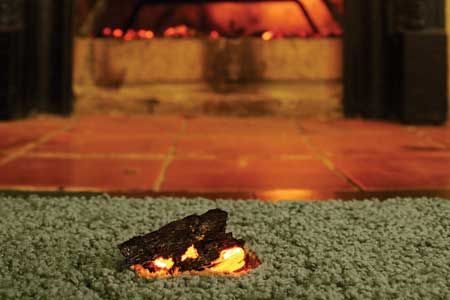You don’t have to buy new carpet or even rearrange the furniture to cover isolated damage from burns, red wine stains, and other blemishes. For the price of a patch kit, some glue, and a star roller—about $40 total—you can make an invisible repair that will last the life of the carpet.
The basic kit, available at flooring distributors and online, includes a hockey-puck-sized carpet cutter and adhesive disks to glue the patch in place. The cutter slices out the damaged section and an identically sized replacement patch. If you don’t have any leftover scraps, harvest a patch from the back of a closet, beneath a radiator, or under furniture that’s rarely moved.
Patch repairs work best on plush, tufted pile with no patterns that require matching. Follow these steps and you’ll be done in about half an hour.
Assess Carpet Damage
Carefully assess the damaged area to determine if patching is the best solution. This method is ideal for small, localized issues. Extensive damage might require professional repair or complete carpet replacement.
When considering patching, evaluate your carpet’s age, overall condition, and the visibility of the damaged area. Below is a guide to common carpet damages and recommended actions.
- Burn marks from embers or cigarettes: Determine if the burn marks are superficial or if they have penetrated deeper into the carpet fibers. Superficial burns may be easier to repair with a simple patch, while deeper burns might necessitate replacing the affected section entirely.
- Stains from spills or pet accidents: Check whether the damage has merely discolored the carpet or affected the underlying padding. If spills or urine have soaked through to the subfloor, you may need to replace the padding, which requires professional assistance.
- Tears or rips from furniture movement: Evaluating the size and location of these tears will help you decide whether a patch will suffice. For major tears and rips, you’ll need an extensive repair process.
- Wear and tear in high-traffic areas: This damage may require periodic patching to maintain the carpet’s appearance and functionality. You may need a full carpet replacement if there is extensive damage.
Carpet Patching Tools and Materials
Below are the tools and supplies you’ll need for your carpet patching project. Most of these items can be purchased separately or found in a basic carpet repair kit. You can buy these kits and a star roller for around $40 from hardware stores and online retailers.
Tools and Supplies
- Adhesive disks
- Carpet cutter or utility knife
- Clean cloth or towel
- Marker or chalk
- Measuring tape
- Star roller
- Small vacuum
Recommended Adhesives and Sealants
- Adhesive disks (included in repair kits)
- Carpet seam sealer
- Heat-activated tape
- Pressure-sensitive adhesive
We recommend checking the manufacturer’s instructions to ensure the adhesive works for your carpet type.
6 Steps To Patch a Carpet
Use the guide below to complete your DIY carpet patching.
Step 1: Clean the Affected Spot
Before patching, thoroughly clean the damaged area and surrounding carpet. Remove any debris, loose fibers, or residue that could interfere with the adhesive. For best results, consider using a gentle carpet cleaner and a soft-bristled brush to lift out any embedded dirt particles.
For stubborn stains, you may need to learn how to remove carpet stains before proceeding with the patch.
For burns: Remove all charred material to prevent it from spreading or affecting the new patch. Thoroughly clean the area to remove any burned residue.
For pet-related damage: Use a specialized pet stain remover and deodorizer to prepare the area before patching.
Step 2: Carefully Cut Out the Damaged Section
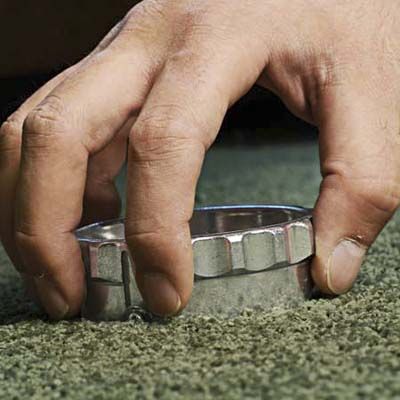
If you’re using a carpet cutter, place the cutter over the damaged area. Next, push down until the pivot screw punches through the backing. Rotate the cutter two or three turns with firm, even pressure. Remove the damaged piece.
If you don’t have a carpet cutter, you can use a sharp utility knife instead. Carefully cut along the marked outline, ensuring you don’t slice through the padding beneath the carpet. Take your time and use a steady hand to follow the outline accurately. You may need to make multiple passes with the knife to ensure a clean cut through the carpet fibers and backing. Keep the blade at a consistent angle and apply even pressure for the best results.
Step 3: Select and Shape the Replacement Patch
Use a piece of leftover carpet from the original carpet installation. If that’s not an option, remove a patch from an inconspicuous area, such as a closet or under furniture. Be aware that light exposure and wear can cause color variations, so select a spot with a similar tone.
Cut the replacement patch to match the size and shape of the hole created in the damaged area. Use the same cutting method you used to remove the damaged section to ensure a perfect fit. Carefully measure and mark the replacement piece before cutting, ensuring consistency with the cutout section.
Step 4: Apply Adhesive for Carpet Patch
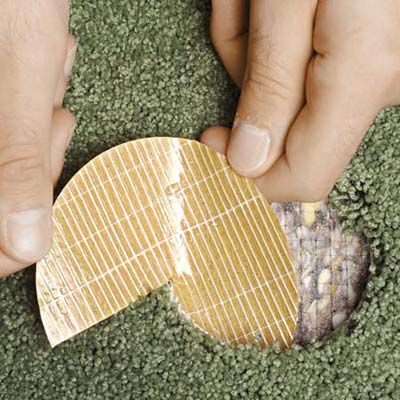
Apply the adhesive evenly around the perimeter of the cutout area. If using an adhesive disk, remove the protective backing and dampen the disk with cool water to temporarily neutralize the glue. Slide the disk’s edge under the carpet between the backing and padding. Wait 3–5 minutes for the adhesive to become tacky before proceeding.
Step 5: Install and Secure the Carpet Patch
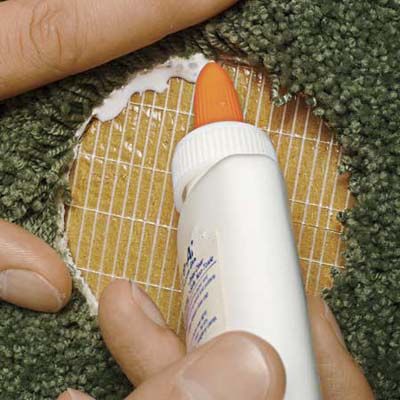
Align the replacement patch with the surrounding carpet, ensuring the pile direction matches. If you marked the direction on the back of the patch, use this as a guide for proper orientation. Press the patch firmly onto the adhesive, working from the center outward to eliminate air bubbles. Apply even pressure across the entire patch to ensure good contact with the adhesive.
Using a rolling tool or applying manual pressure helps ensure the patch adheres securely to the surrounding carpet.
Step 6: Blend and Finish Carpet
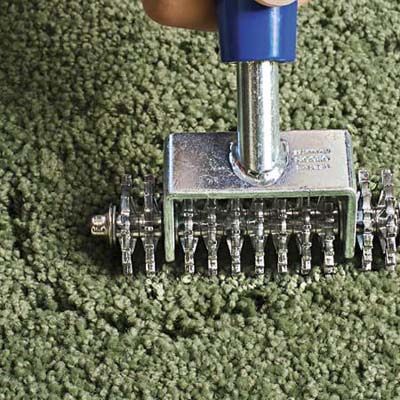
Use a star roller to straddle the edge of the patch and press down firmly as you guide it around the perimeter twice. Roll over the patch from different directions until the seam disappears.
After rolling, you may need to trim any excess fibers that stick up around the patch edges. Use sharp scissors to carefully snip these fibers level with the surrounding carpet. Use small, precise cuts to avoid removing too much material and creating uneven areas.
Let the adhesive cure for 24 hours before you vacuum or walk on the patch.
Professional vs. DIY Carpet Patching
While minor carpet patching can be accomplished by most do-it-yourselfers, repairs for extensive damage or specialty carpets will require a professional.
You should consider professional carpet patching in the following cases:
- If there is damage extending to the subfloor
- If you don’t have a patch of matching replacement material
- If you have patterned or specialty carpets
- If your carpet has large or multiple damaged areas
Professional carpet repair services provide expertise and specialized tools for handling complex repairs that may be difficult to manage on your own. Assess the extent and nature of the damage to decide if hiring a professional is the best option.
Prevent Future Carpet Damage
Taking proactive measures can help extend the life of your carpet and prevent the need for future repairs. Here are some tips for maintaining and protecting your carpet.
- Vacuum regularly to prevent dirt buildup
- Clean spills immediately to prevent staining
- Use doormats to reduce tracked-in dirt
- Rotate furniture periodically to distribute wear
Consider using area rugs or runners in high-traffic zones to protect your carpet. They are easy solutions to protect your carpet from excessive wear in busy areas and serve stylish additions to your home decor. You could also install a floor medallion in entryways or other focal points to add both protection and visual interest to your flooring.
Alternatives to Patching
In some cases, patching may not be the best solution. Consider these alternatives for addressing carpet damage.
Area Rug Placement
Strategically placed area rugs offer a quick, stylish solution to cover carpet damage, especially in highly visible areas where patches might stand out. This approach not only conceals damaged spots but also adds character to your room. Area rugs are versatile, allowing for easy replacement or relocation as needed, making them an adaptable and decorative fix for carpet issues.
Carpet Dyeing
Professional carpet dyeing offers an effective solution for large stains or discoloration that cleaning alone can’t fix. This method restores uniform color to your carpet without needing patching, making it less invasive. It’s particularly useful for addressing extensive discolored areas or stubborn stains, reviving your carpet’s appearance seamlessly.
Our Conclusion
Carpet patching is a practical, affordable way to repair localized damage without replacing the entire floor covering. While many homeowners successfully patch carpets themselves, complex repairs or valuable carpets may require professional expertise. Complete regular maintenance and take preventive measures to avoid future damage and maintain your carpet’s appearance.
